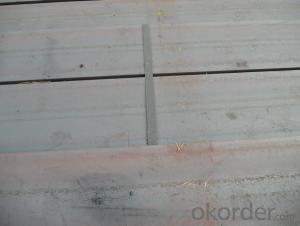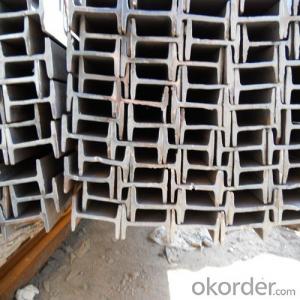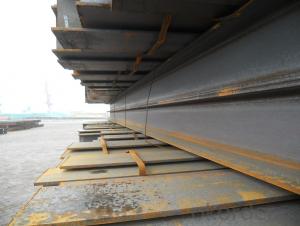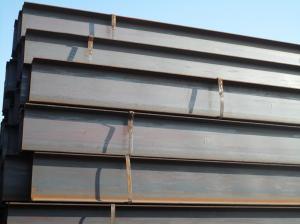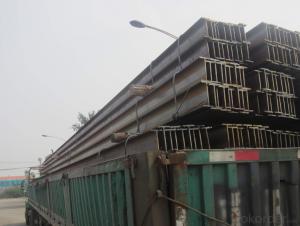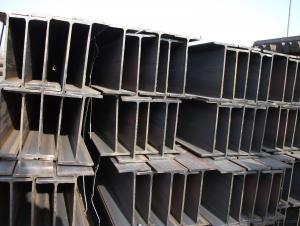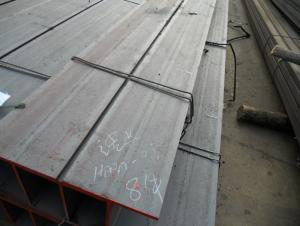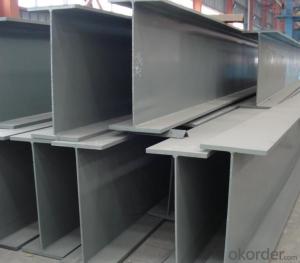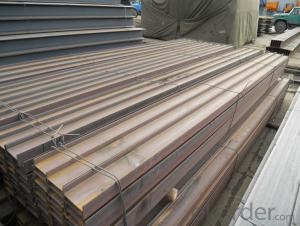Hot Rolled JIS Standard Steel H Beam Structure
- Loading Port:
- China Main Port
- Payment Terms:
- TT or LC
- Min Order Qty:
- -
- Supply Capability:
- -
OKorder Service Pledge
OKorder Financial Service
You Might Also Like
Product Description:
OKorder is offering high quality Hot Rolled Steel I-Beams at great prices with worldwide shipping. Our supplier is a world-class manufacturer of steel, with our products utilized the world over. OKorder annually supplies products to European, North American and Asian markets. We provide quotations within 24 hours of receiving an inquiry and guarantee competitive prices.
Product Applications:
Hot Rolled Steel I-Beams are ideal for structural applications and are widely used in the construction of buildings and bridges, and the manufacturing, petrochemical, and transportation industries.
Product Advantages:
OKorder's Steel I-Beams are durable, strong, and resist corrosion.
Main Product Features:
· Premium quality
· Prompt delivery & seaworthy packing (30 days after receiving deposit)
· Corrosion resistance
· Can be recycled and reused
· Mill test certification
· Professional Service
· Competitive pricing
Product Specifications:
Manufacture: Hot rolled
Grade: Q195 – 235
Certificates: ISO, SGS, BV, CIQ
Length: 6m – 12m, as per customer request
Packaging: Export packing, nude packing, bundled
SIZE(mm) | DIMENSION(kg/m) |
100*100 | 16.9 |
125*125 | 23.6 |
150*75 | 14 |
150*150 | 31.1 |
148*100 | 20.7 |
198*99 | 17.8 |
200*100 | 20.9 |
248*124 | 25.1 |
250*125 | 29 |
Packaging & Delivery of Hot Rolled Structural Steel H Beam
1. Packing: it is nude packed in bundles by steel wire rod
2. Bundle weight: not more than 3.5MT for bulk vessel; less than 3 MT for container load
3. Marks:
Color marking: There will be color marking on both end of the bundle for the cargo delivered by bulk vessel. That makes it easily to distinguish at the destination port.
Tag mark: there will be tag mark tied up on the bundles. The information usually including supplier logo and name, product name, made in China, shipping marks and other information request by the customer.
If loading by container the marking is not needed, but we will prepare it as customer request.
4. Transportation: the goods are delivered by truck from mill to loading port, the maximum quantity can be loaded is around 40MTs by each truck. If the order quantity cannot reach the full truck loaded, the transportation cost per ton will be little higher than full load.
5. Delivered by container or bulk vessel
FAQ:
Q1: Why buy Materials & Equipment from OKorder.com?
A1: All products offered byOKorder.com are carefully selected from China's most reliable manufacturing enterprises. Through its ISO certifications, OKorder.com adheres to the highest standards and a commitment to supply chain safety and customer satisfaction.
Q2: How do we guarantee the quality of our products?
A2: We have established an advanced quality management system which conducts strict quality tests at every step, from raw materials to the final product. At the same time, we provide extensive follow-up service assurances as required.
Q3: How soon can we receive the product after purchase?
A3: Within three days of placing an order, we will begin production. The specific shipping date is dependent upon international and government factors, but is typically 7 to 10 workdays.
Q4: What makes stainless steel stainless?
A4: Stainless steel must contain at least 10.5 % chromium. It is this element that reacts with the oxygen in the air to form a complex chrome-oxide surface layer that is invisible but strong enough to prevent further oxygen from "staining" (rusting) the surface. Higher levels of chromium and the addition of other alloying elements such as nickel and molybdenum enhance this surface layer and improve the corrosion resistance of the stainless material.
Q5: Can stainless steel rust?
A5: Stainless does not "rust" as you think of regular steel rusting with a red oxide on the surface that flakes off. If you see red rust it is probably due to some iron particles that have contaminated the surface of the stainless steel and it is these iron particles that are rusting. Look at the source of the rusting and see if you can remove it from the surface.
Images:

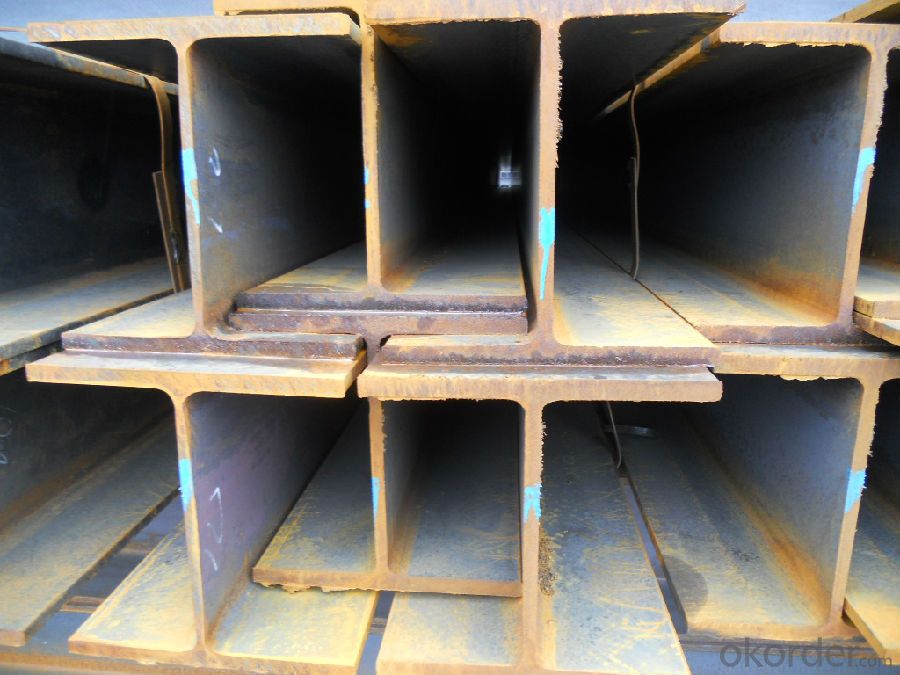
- Q: Are there any health concerns associated with Steel H-Beams?
- Steel H-Beams can potentially raise health concerns due to their composition. Typically made from carbon steel, which contains trace amounts of lead, chromium, and nickel, these elements can pose health risks if they are released into the environment or individuals come into direct contact with them. One issue to consider is lead poisoning, a serious health condition caused by exposure to this toxic heavy metal. Particularly harmful to children, if lead is present in steel beams and released into the air or water, it can contaminate the surrounding environment and endanger human health. Another worry involves the presence of chromium and nickel. These metals can trigger allergic reactions and skin irritation in sensitive individuals. Direct contact with steel beams containing these elements can result in dermatitis or other skin conditions. Additionally, the production and processing of steel involve the use of various chemicals and substances that can be harmful if not handled and disposed of properly. For instance, the welding process used to fabricate steel beams may release toxic fumes like zinc oxide or manganese, which can negatively impact respiratory health if inhaled. It is crucial to emphasize that the health risks associated with Steel H-Beams can be minimized by following appropriate handling, storage, and disposal practices. Employers and workers who come into contact with steel beams should receive education about potential health hazards and take necessary precautions to safeguard themselves. Furthermore, strict adherence to environmental regulations and safety standards is essential to ensure that steel production processes do not pose any risk to human health or the environment.
- Q: How do Steel H-Beams contribute to the overall natural ventilation of a structure?
- Steel H-Beams do not directly contribute to the natural ventilation of a structure. Their primary function is to provide structural support and distribute the load of the building. However, the design and construction of a structure using steel H-Beams can allow for the incorporation of ventilation systems such as windows, vents, and openings, which can enhance natural airflow and ventilation within the building.
- Q: What are the typical spans and spacing for steel H-beams in roof structures?
- The spans and spacing for steel H-beams in roof structures can vary depending on factors such as roof design, load requirements, and regional building codes. However, there are some general guidelines to follow. For smaller residential or light commercial roof structures, steel H-beams typically span from 10 to 25 feet. The spacing between beams can range from 4 to 8 feet. In larger commercial or industrial roof structures, the spans can be much greater, exceeding 100 feet. The spacing between beams in these cases is usually between 10 to 20 feet. It is important to remember that these are only general guidelines. A structural engineer or architect should determine the specific requirements for spans and spacing. They will consider factors such as roof material weight, anticipated snow or wind loads, and any building code requirements. Adhering to proper spans and spacing is crucial for ensuring the safety and structural integrity of the roof structure. It is always recommended to consult with a professional to determine the most appropriate spans and spacing for steel H-beams in roof structures.
- Q: Can steel H-beams be used in the construction of hospitals or healthcare facilities?
- Yes, hospitals or healthcare facilities can make use of steel H-beams in their construction. Steel H-beams are extensively used in the field of construction due to their robustness, longevity, and adaptability. They provide exceptional structural support and are commonly employed in the construction of sizable edifices, including hospitals and healthcare facilities. In healthcare facilities, the utmost importance is placed on structural integrity and safety, both of which are met by steel H-beams. They possess the ability to endure heavy loads and bestow stability upon the building, thus ensuring the safety of patients, staff, and equipment. Steel H-beams also possess a remarkable resistance to fire and are non-combustible, a vital characteristic for the safety of healthcare facilities. Furthermore, steel H-beams offer a plenitude of design options. They can be effortlessly customized to meet specific architectural requirements and can support various types of roofing, flooring, and wall systems. This versatility allows for efficient space planning and the creation of larger open areas, often necessary in healthcare facilities to accommodate medical equipment, patient rooms, and specialized areas such as operating rooms and laboratories. Additionally, steel H-beams boast an extended lifespan and necessitate minimal maintenance. They are impervious to corrosion, pests, and decay, making them a dependable choice for healthcare facilities that need to remain operational over an extended duration. In conclusion, the strength, durability, safety features, design flexibility, and low maintenance requirements of steel H-beams make them an ideal choice for the construction of hospitals and healthcare facilities.
- Q: How do steel H-beams perform in sports arena construction?
- Steel H-beams are commonly used in sports arena construction due to their excellent structural performance. These beams provide superior strength and load-bearing capabilities, making them ideal for supporting the heavy loads and stresses experienced in sports arenas. Steel H-beams are designed to distribute weight evenly, which helps to evenly distribute loads from the roof, lighting systems, and other equipment in the arena. This ensures the structural integrity of the building and prevents any potential failures or collapses. Furthermore, steel H-beams have high resistance to bending and twisting forces, making them suitable for withstanding the dynamic loads generated by sporting events such as basketball games or concerts. They also have excellent fire resistance, which is crucial for the safety of the spectators and athletes. Additionally, steel H-beams are versatile and can be easily customized to meet the specific design requirements of sports arenas. They can be fabricated into various lengths, sizes, and shapes, allowing architects and engineers to create innovative and aesthetically pleasing structures. Moreover, steel H-beams have a long lifespan and require minimal maintenance, making them a cost-effective choice for sports arena construction. They are also recyclable, which aligns with sustainable construction practices. In summary, steel H-beams are essential components in sports arena construction due to their exceptional strength, load-bearing capabilities, resistance to bending and twisting forces, fire resistance, versatility, and long lifespan. These beams ensure the safety and structural integrity of sports arenas, providing a solid foundation for hosting sporting events and other activities.
- Q: Can steel H-beams be used in marine environments?
- Yes, steel H-beams can be used in marine environments. However, they need to be properly coated or treated to withstand corrosion from the saltwater and other harsh conditions present in marine environments.
- Q: Can steel H-beams be used for railway stations?
- Yes, steel H-beams can be used for railway stations. They are commonly used in the construction of railway station platforms, bridges, and other infrastructure due to their high strength, durability, and ability to support heavy loads.
- Q: What are the advantages of using steel H-beams over other types of beams?
- There are several advantages of using steel H-beams over other types of beams. Firstly, steel H-beams have a high strength-to-weight ratio, which means they can support heavy loads while being relatively lightweight themselves. This makes them ideal for applications where a strong and durable structural support is required, such as in the construction of buildings, bridges, and industrial structures. Secondly, steel H-beams have a consistent shape and size, which makes them easy to install and work with. They are manufactured to strict standards, ensuring uniformity and precision in their dimensions. This uniformity allows for quick and efficient assembly, saving time and labor costs during construction. Thirdly, steel H-beams have excellent load-bearing capacity. The H shape allows for the distribution of weight evenly along the beam's length, enabling it to support heavy loads without bending or buckling. This makes them suitable for long-span applications, where large distances need to be covered without the need for additional support columns. Furthermore, steel H-beams are highly versatile and can be used in a wide range of applications. They can be easily customized and fabricated to meet specific project requirements, whether it's in residential, commercial, or industrial construction. Additionally, steel H-beams can be easily connected and joined together using various methods, allowing for flexibility in design and construction. Lastly, steel H-beams are durable and resistant to corrosion, making them suitable for both indoor and outdoor applications. They have a long lifespan and require minimal maintenance, reducing the overall lifecycle costs. This durability ensures the structural integrity of the building or structure over time, providing long-term stability and safety. In conclusion, the advantages of using steel H-beams over other types of beams include their high strength-to-weight ratio, consistent shape and size, excellent load-bearing capacity, versatility, durability, and resistance to corrosion. These factors make steel H-beams a preferred choice in various construction projects, ensuring the structural stability and longevity of the built environment.
- Q: Are steel H-beams suitable for structures with architectural features?
- Yes, steel H-beams are suitable for structures with architectural features. Steel H-beams are widely used in construction due to their strength, versatility, and ability to support various architectural designs. They can be fabricated and shaped to create unique architectural features while providing structural support. Their durability and load-bearing capacity make them an ideal choice for creating aesthetically pleasing structures with intricate architectural details.
- Q: What are the maximum deflection limits for steel H-beams?
- The maximum deflection limits for steel H-beams are influenced by several factors, including the beam type, size, and adherence to industry standards. Deflection limits are generally set to ensure the beam's structural integrity and safety under different loads. In the construction field, building codes and engineering standards typically specify deflection limits for steel H-beams. For instance, the American Institute of Steel Construction (AISC) offers guidelines in their specification documents. According to AISC, the maximum allowable deflection for a simply supported H-beam should not exceed the beam's length divided by 360. However, it's important to note that these deflection limits are not universally applicable and can vary based on the specific project requirements. Factors such as the type of load, span length, and intended use of the beam can also impact the maximum allowable deflection. To determine the appropriate deflection limits for a steel H-beam, it is advisable to consult relevant building codes or engineering standards specific to your project. Alternatively, seeking the expertise of a structural engineer can provide accurate deflection limits that prioritize the safety and performance of the H-beam in its intended application.
Send your message to us
Hot Rolled JIS Standard Steel H Beam Structure
- Loading Port:
- China Main Port
- Payment Terms:
- TT or LC
- Min Order Qty:
- -
- Supply Capability:
- -
OKorder Service Pledge
OKorder Financial Service
Similar products
Hot products
Hot Searches
Related keywords
